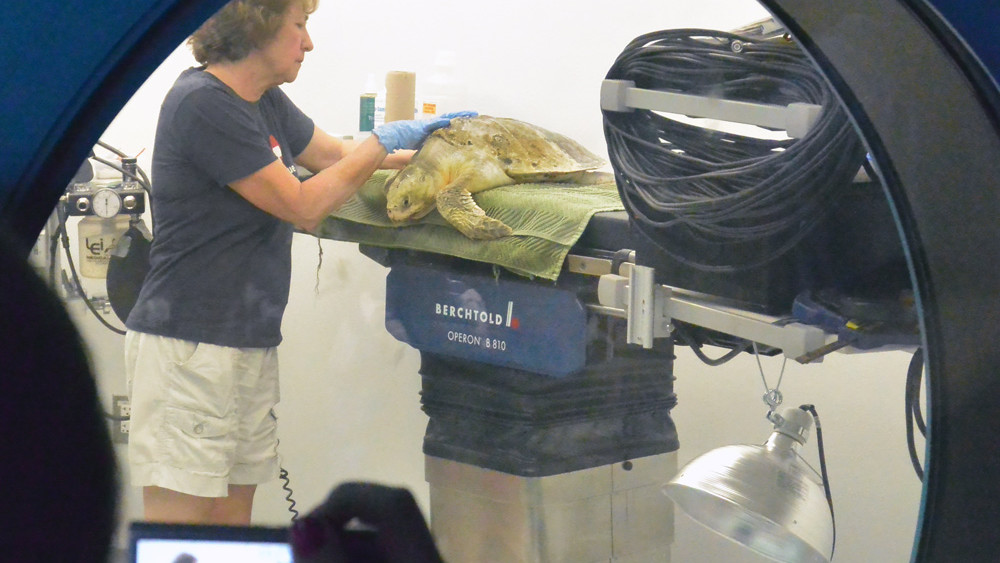Kemp’s ridley (Lepidochelys kempii)
Stranding Location: Bohicket Creek, SCArrival Date: 06/20/2015Age: JuvenileWeight: 5.56 kg (~12 lb.)Case History
This critically endangered Kemp’s ridley sea turtle was found floating and unable to dive in Bohicket Creek on June 20th. For sea turtles, being stuck at the surface of the water leaves them prone to being hit by boats. In addition, the inability to dive is a death sentence as their primary food sources are typically located along the seafloor. For carnivorous Kemp’s ridleys, being unable to dive means they are unable to prey on crabs. Young ridleys like this one prefer walking crabs and transition to eating swimming crabs (like blue crabs) when their hunting abilities improve as adultsTreatment
Named “Maybank,” this small juvenile was clearly in distress upon arrival to our sea turtle hospital. Although his blood work was fairly good (PCV 31%, total solids 3.2, glucose 108), he was not breathing properly. Maybank’s heart rate was strong at 40 beats per minute, but respirations were very shallow. In addition, it was clear from simply picking him up that his body cavity contained a massive amount of excess air. Our team performed all relevant initial treatments and placed this ridley in very shallow water overnight.Updates
25 June 2015: Maybank was taken to Charleston Veterinary Referral Center in nearby West Ashley for a CT scan today. Unfortunately, we now have confirmation that Maybank is suffering from severe pulmonary bulla. These bullae are simply discrete places where a portion of the lung tissue has overly filled with air, like a large air sac or balloon. Enlarged bullae interfere with the lung’s ability to expand and contract and, thus, less oxygen is moved into the blood, similar to emphysema.The CT also confirmed a massive amount of air in Maybank’s body cavity (i.e. not in the lungs or intestines, but in the body cavity space itself where the organs are housed). Pulmonary bulla are the most likely cause due to the fact that, if the bullae burst, air would then leak into the body cavity. Excess air in the body cavity is comparable to a human pneumothorax and makes breathing nearly impossible. Currently, this ridley’s lungs are functioning with only about 10% of their normal volume because all of the excess air in the body cavity is surrounding the outside of the lungs and preventing them from expanding like normal. Prognosis is very poor and our vet is doubtful that this ridley will ever be able to return to the wild.29 June 2015: Our veterinarian opted to try a risky procedure today in an effort to aid Maybank’s breathing. We inserted a needle into the body cavity where the air is trapped and easily removed approximately 1.5 liters of air (equivalent to nearly a half gallon of air). For the first time in our care, Maybank took numerous deep breaths and seemed quite shocked at his ability to do so! The lungs are not fully able to expand yet, but this is certainly an improvement. We will carefully monitor him over the next week or so to see if the body cavity refills with air.9 July 2015: We easily tapped another few liters of air (more than a half-gallon) from Maybank this morning. Radiographs before the procedure were promising, as Maybank’s body cavity didn’t fully refill with air after our last tap on June 29th. Radiographs after Maybank’s procedure today are exciting, as this ridley’s lungs are now able to expand to almost their normal volume. Our vet is a bit more optimistic about Maybank’s long-term prognosis, but this turtle still has quite a lot of healing left to do.24 July 2015: Thanks to a very generous donation of state-of-the-art endoscopy equipment by an anonymous donor, our team was able to more accurately diagnose Maybank’s severe lung condition yesterday. We inserted the tiny endoscopic camera into this turtle’s hip region in order to visualize his lungs and were shocked, but not surprised, by what we saw. (One exciting thing about this equipment is that it projects the endoscopy image onto a large monitor so that everyone in the surgery room can clearly see what the vet is observing in real time.) The left lung shows clear signs of recent chronic infection, and we quickly discovered a sizeable hole leaking air into the body cavity from a large bullae on that side. The good news is that the internal infection appears to be fully cleared up thanks to our treatments. The bad news is that, unless we can somehow close the visible hole in the lung tissue (and any more that may be present), Maybank will not be able to return to the wild.28 July 2015: Following his endoscopy procedure, Maybank resumed “normal” behaviors, which meant he still floated at the surface in his tank and was fairly inactive. On Sunday morning, he refused to eat his mackerel but did not seem abnormal otherwise. Unfortunately, this little ridley was found unresponsive at approximately 2 P.M. Sunday afternoon, and resuscitation efforts were unsuccessful.Our veterinarian conducted a full autopsy on this animal yesterday, and results confirmed our diagnosis from the endoscopy procedure. Maybank’s lung issues were astonishingly severe and, likely, painful. Signs of severe, chronic internal infection, although successfully resolved by our antibiotic treatment, were everywhere. This little ridley would probably never have healed enough to return to the wild. We are so very sad that Maybank has passed, but are grateful that he is no longer suffering from whatever severe trauma initially caused his condition. Rest in peace, Maybank.

